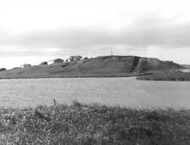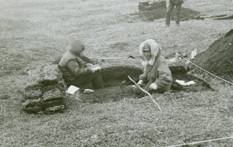
The Amalik Bay Archeological District is a geographic area with a significant number of archaeological sites in Alaska. It is located on the Pacific coast of Katmai National Park and Preserve, in the mainland portion of Kodiak Island Borough, Alaska.

The Birnirk Site is an archaeological site near Utqiagvik, Alaska. It includes sixteen prehistoric mounds which have yielded evidence of very early Birnirk and Thule culture. It is the type site of the Birnirk culture, and was designated a National Historic Landmark in 1962 for its archaeological importance in understanding prehistoric Arctic cultures.

The Brooks River Archaeological District encompasses a large complex of archaeological sites along the banks of the Brooks River in Katmai National Park and Preserve in the U.S. state of Alaska. It includes at least twenty separate settlement sites with documented occupation dates from 2500 BCE to recent (post-contact) history. It was declared a National Historic Landmark in 1993. The site is partly occupied by the Brooks Camp, one of the major visitor areas of the park.

The Chaluka Site is a prehistoric archaeological site and National Historic Landmark in Nikolski, Alaska, on Umnak Island in the Aleutian Islands of southwestern Alaska. The site documents more than 4,000 years of more-or-less continuous occupation of the area now occupied by the modern village of Nikolski. The site includes a large midden, yielding much information about the origins of the Aleut people.

The Gallagher Flint Station Archeological Site is an archaeological site and National Historic Landmark in northern Alaska. Discovered in 1970 during the construction of the Trans-Alaska Pipeline, it yielded a radiocarbon date of 10,540 B.P., making it the oldest site of human activity then known in the state.

The Ipiutak Site is a large archaeological site at Point Hope in northwest Alaska, United States. It is one of the most important discoveries in this area, competing only with Ekven, Russia.

The Iyatayet Site is an archaeological site and National Historic Landmark located on the northwest shore of Cape Denbigh on Norton Bay in Nome Census Area, Alaska. It shows evidence of several separate cultures, dating back as far as 6000 B.C. It was excavated starting in 1948 by J. Louis Giddings, the pioneering archaeologist of the area. It is significant as the type site of the Norton culture, representative of human occupation c. 500BCE-500CE, first described by Giddings in 1964. It is also significant for the Cape Denbigh Flint Complex, which lay underneath the Norton materials, and provides evidence of some of the earliest human activity in the region. The site was declared a National Historic Landmark in 1961.

The Onion Portage Archeological District encompasses a major archaeological site in Kobuk Valley National Park in northwestern Alaska. The site is a deeply stratified site, at which archaeologists have located nine complexes ranging dating from approximately 6500BC to AD1700. The site has been of critical benefit for the study of Arctic cultures, and is used to determine the cultural chronology of the region.
The Palugvik Site, also known as Palugvik Archeological District, is an archaeological site on Hawkins Island in Prince William Sound, near Cordova, Alaska, within Chugach National Forest. The site, first excavated in 1930, was the first to provide a view of prehistoric human habitation in Prince William Sound, the ancestral home of the Chugach people, and is one of the two primary sites for identifying the sequence of occupation in the area. The site was declared a National Historic Landmark in 1962, and listed on the National Register of Historic Places in 1966.

The Wales Site, whose principal component is the Kurigitavik mound, is a well-documented archeological site on the Cape Prince of Wales, near Wales, Alaska. This site has artifacts from the Birnirk culture as well as the first discovery in Alaska of the later Thule culture. The site was designated a National Historic Landmark in 1962 for its archaeological significance.

This is a list of the National Register of Historic Places listings in Denali Borough, Alaska.

The Tangle Lakes are a 16-mile (26 km) long chain of lakes connected by streams in interior Alaska. They form the headwaters for the Delta River.

Kijik is a ghost town in Lake and Peninsula Borough, Alaska, United States. An Athabascan village that was established on the shores of Lake Clark in the Alaska Range, its population was recorded at 91 in the 1880 United States Census and declined thereafter, falling to approximately 25 individuals by 1904. Today, the village has been abandoned. The ghost town is located within the bounds of Lake Clark National Park and Preserve.
This is a list of the National Register of Historic Places listings in Denali National Park and Preserve.

Chugachik Island is a small island in the upper reaches of Kachemak Bay, an indent in the Kenai Peninsula of south-central Alaska. The island falls within the bounds of Kachemak Bay State Park.
The Dakah De'nin's Village Site is an archaeological site near Chitina, Alaska. The site, first identified in 1971 and excavated in 1973, is named for an Ahtna clan chief who the local people believe lived there. Materials recovered at the site include glass trade beads dating to the early 19th century. Dendrochronological analysis of wood used in house construction at the site also yield dates consistent with occupation between about 1810 and 1830. The site includes a feature consisting of five stone slabs, which is consistent with oral tradition concerning the grave site of Dakah De'nin's.

The Swan Point Archeological Site is located in eastern central Alaska, in the Tanana River watershed. It is one of a collection of sites in the area that have yielded the oldest evidence of human habitation in the state, and provide the only evidence to date of megafauna no longer found in Alaska, including extinct varieties of wapiti (elk), bison, and mammoth. Finds colocated with human artifacts at the site have given radiocarbon dates of 14,000 years, indicating the site was occupied around 12,000 BCE.
The Chugwater Site is a prehistoric archaeological site on the banks of the Tanana River near Moose Creek, Alaska. The site covers more than 40 acres (16 ha) on a bluff overlooking the river, and consists of widely scattered stone toolmaking debris, interspersed with other artifacts. The area was extensively sampled in 1982-83 by the United States Army Corps of Engineers, identifying a variety of stone tools and types of stone used in their manufacture. A more extensive excavation of the site took place in 1984, exposing a number of larger stone tools and projectile heads, as well as microblades, which are usually attached to bone or wood handles. One projectile point found is of a style similar to those found at another Alaska site which has been dated back 10,000 years.

The Kukak Village Site is a prehistoric and historic archaeological site, located on the shore of Kukak Bay, on the south coast of the Alaska Peninsula in Katmai National Park and Preserve. The area was documented to be occupied in the early 20th century, and was abandoned after the 1912 volcanic eruption of Novarupta. The Kukak Bay area is also of prehistoric significance, with researchers identifying 89 depressions as likely sites of subterranean houses, and a refuse midden.

Magnetic Island is a small island on the north side of Tuxedni Bay, an inlet on the lower west side of Cook Inlet in south-central Alaska. The island is surrounded by mudflats that are under water during high tides. The island got its name from the presence of magnetism identified during a geological survey in 1951. Its shape and geology are heavily influenced by Mount Redoubt and Mount Iliamna, two active volcanoes located less than 20 miles (32 km) away.


















